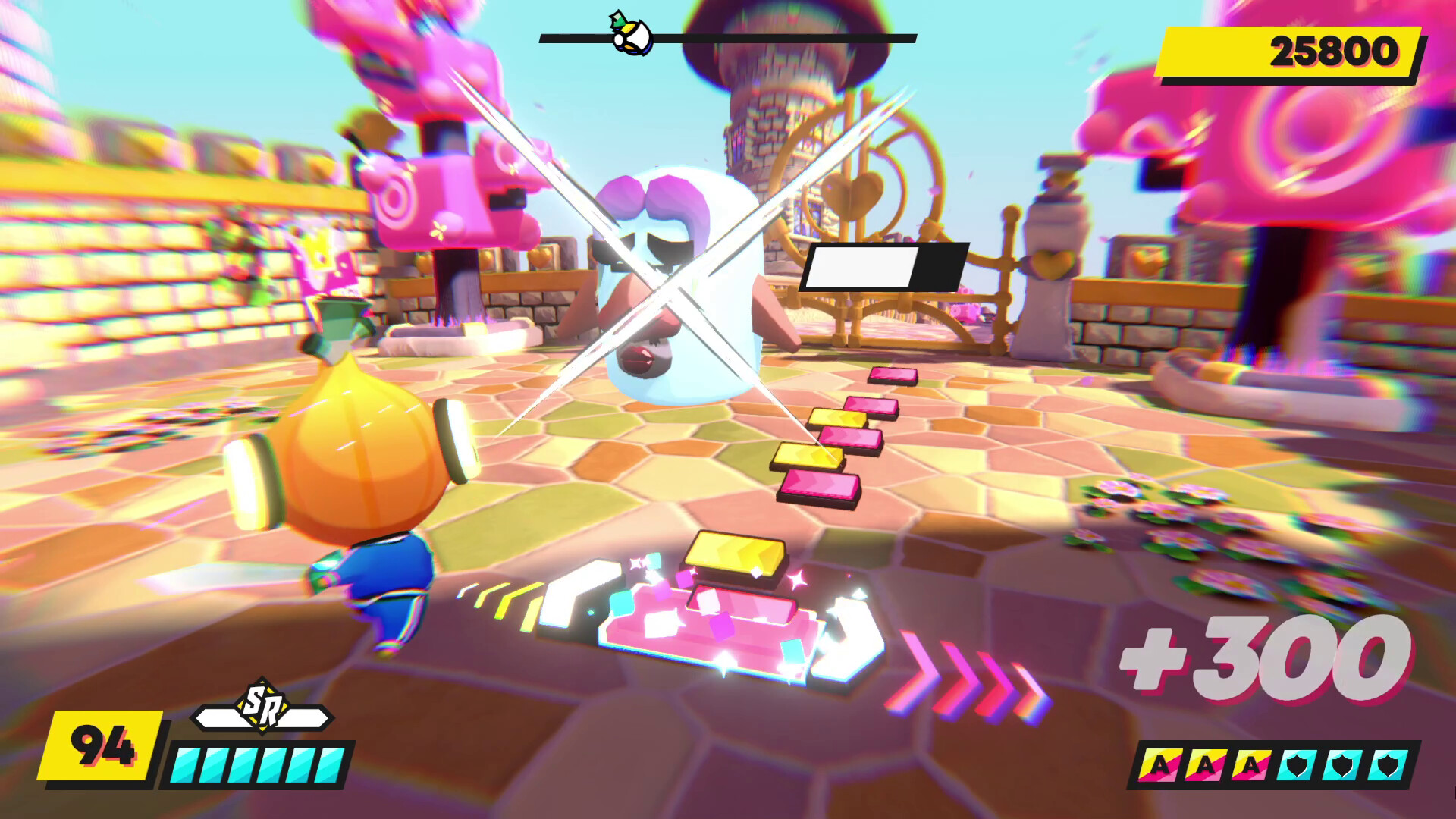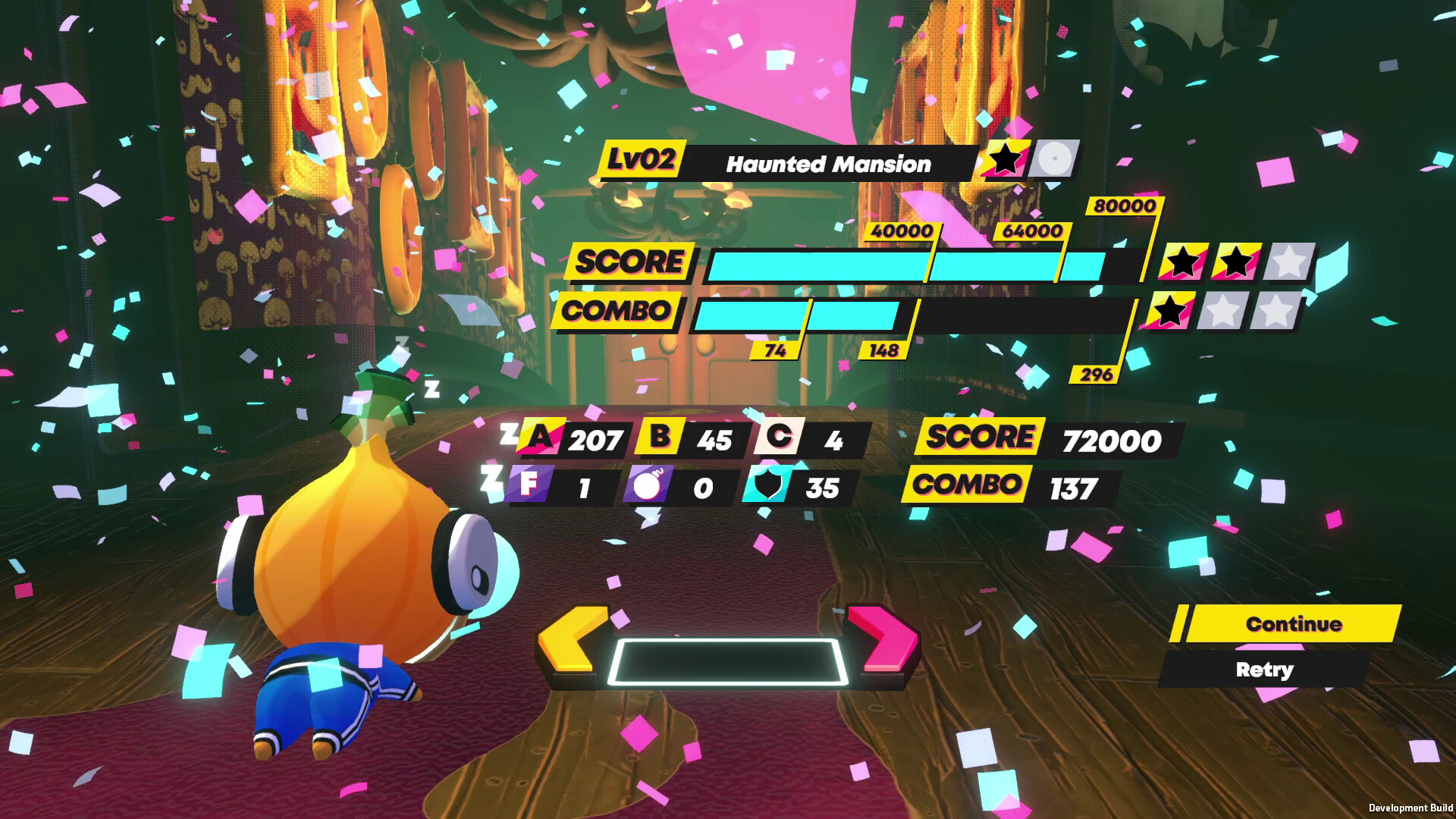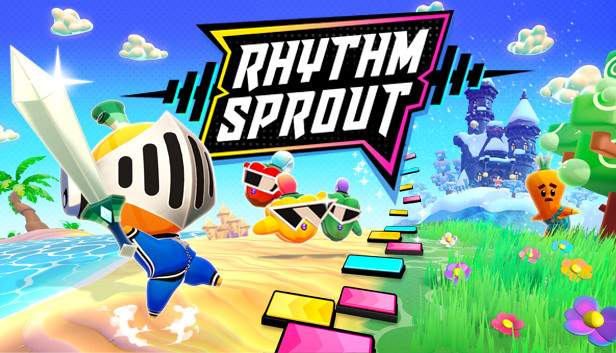Many fond memories were forged when rhythm games were all the rage, and friends would frequently come over to my house to play Guitar Hero, Rock Band or Beatles Rock Band. Those games were a blast to play, and they were even better when you played with friends. Even though I’m more of a loner, and a solo gamer at heart, I looked forward to each and every second of those parties, and will always hold rhythm games in high regard as a result. This is one reason as to why I jumped at the opportunity to review Rhythm Sprout: Sick Beats & Bad Sweets; a new game from tinyBuild and developer SURT.
Rhythm Sprout is what its title suggests. It’s a music slash rhythm game wherein you play as an onion who’s been sent on a quest by the lettuce king. You see, the Vegetable Kingdom is under attack from unexpected visitors who hail from the sugar realm. Yes, that’s the plot. However, while it sounds basic and perhaps even dumb, the story is a highlight here. The characters have depth, and there’s more to the plot than you’d ever expect. In fact, it’s quite funny and well written to boot.
There are approximately twenty stages in the main campaign, with additional ones coming via bonus levels (which are unlocked when you earn a certain amount of stars, for hitting certain score and combo plateaus during each level) and the prequel story. The latter lasts only about five or six stages, itself, and tells of Sprout’s first time working for the King. A time in which he was sent after two chili peppers who weren’t so good at paying their taxes.

The goal is to get from the start of each stage to its end, which is pretty simple and to be expected. However, you’ll have to do at least an okay job of hitting buttons to the beat if you plan to succeed. You’ll have red and yellow ones flying at you in different patterns and timings, and will need to press a face button (I chose B) and a directional button on the d-pad (I chose down) to make contact. Failure to do so won’t hurt you, but it will affect your score.
It’s the light blue notes that will kick your ass. These are blocks, and are present even when you’re not in the midst of battle, which isn’t as frequent as you’d expect. I guess the developers thought the game would be a bit boring if it only had two types of notes 70% of the time. Blocking is as easy as pressing a shoulder button, like LB, but if you miss doing so you’ll lose a piece of health. My advice is to keep an eye out for the blue notes more-so than any others, and focus on them. As long as you keep hitting the blues you’ll be okay; score be damned.
After a while, the game will introduce spoof notes. These are black and purple notes that can easily mess you up. Hitting one kills your combo, but doing so thankfully won’t hurt you physically. That’s one nice thing about this game: only the blue ones cause any pain.
It took a few minutes to get used to Rhythm Sprout‘s controls, and how I’d need to hold my hand in a sort of claw to play it. That said, it wasn’t uncomfortable and was something I got used to relatively quickly. The controls were surprising, though. I didn’t expect to have to use three different types of buttons, and have my hands/fingers positioned at different parts of the controller.

When battles do occur, they’re always one-on-one, but some bad guys will swap out mid-fight. Someone else will replace them, and then they’ll change places again, and so on. Even during these engagements, all you need to do is focus on the notes; especially the blue ones. As long as you block when the enemy attacks you’ll be okay, and won’t lose a precious health piece, of which Sprout has several.
This is true of boss battles, as well.
Rhythm Sprout isn’t an easy game, but it’s not as hard as I feared. The thing is, though, that its difficulty is uneven and fluctuates throughout the campaign and bonus levels. Some of the latter stages are easier than some of the earlier or mid-campaign ones, which was kind of odd. I didn’t mind that too much, though, because I was worried I’d encounter a level that wouldn’t be beatable with my mid-level skill.
That was a way of saying that my scores weren’t great, but I managed to beat the game and did okay. Some of the red and yellow note combinations require great reflexes, which I don’t have anymore, and it wasn’t hard to miss a number of notes in a row after getting off track.
If you’re having a difficult time with this game, don’t feel ashamed about turning easy mode on. It combines the red and yellow notes, making it so that you only need to press one button. You won’t need to deal with two reds and then a yellow; it’s just notes in a straight line. The blue ones remain, however, so make sure to pay attention to them.

Easy mode also increases Sprout’s health quite a bit, which is a nice bonus. It can be helpful during super challenging stages. I admittedly used easy mode to get through the side story quicker, but only for about half of its levels or so. I needed to try it out, and was getting tired. I’d already beat the game on its regular difficulty.
Another helpful part of Rhythm Sprout is the Sugar Rush ability, which can be used one time per level. By pressing the left and right triggers at the same time, you’ll make all notes worth more points, and will only need to press one button to hit them. This multiplier also refills your health, making it a godsend at times.
Once you finish a stage, or perhaps after you beat the game in its entirety, you can go back and use modifiers to change things up. These include mirroring the notes so that the yellow ones require a face button and the red ones are hit with a directional button. On top of that, it’s also possible to add turbo, if you’re into making things crazier, or shuffle the notes. If you’re feeling masochistic, all of the above can be toggled one at once. Hell, you can even randomize everything.
You may also want to go back through everything to unlock all of the many different costumes and special weapons. I only unlocked several during my play through, and barely made a dent in what’s there for unlocking. This included different coloured tracksuits (because, of course Sprout wears colorful tracksuits) and a boss’ weapon.
Of course, Rhythm Sprout: Sick Beats & Bad Sweets is a music game at heart. As such, it’s important that we talk about the original soundtrack, which was surprisingly good to great. Most of the songs are electronica, and would do well at a rave, but every so often you’ll get an awesome metal riff or tune during a boss battle. Those were my favourites.

In all honesty, I wasn’t expecting much from the soundtrack given that this is an indie game. However, I was very pleasantly surprised and gladly proven wrong. There’s a lot to like about the songs you’ll play through, which get better as you go along.
The visuals are also quite nice, although they’re a bit basic in comparison to some other Xbox Series X/S games. Everything is colourful and stylized, with characters who are all designed around things like vegetables and pieces of candy, including gingerbread men and chocolate bars. You’ll also find yourself hitting the beat throughout some unique and colourful locations, such as the trippy interior of a gingerbread house, a giant beanstalk, a candy factory, a haunted mansion, a couple kingdoms and a regular street in a not so regular, candy-infested, suburb. Although it won’t win any awards for visuals, there’s absolutely nothing wrong with these, and they do their job very well.
If you’re looking for a new rhythm game, or want to support a good indie, make sure to check out Rhythm Sprout: Sick Beats & Bad Sweets. I was worried that I wouldn’t like it, or that I’d find it too difficult, but it really fell into a sweet spot in both regards. In the end, I was very pleasantly surprised by it, and can recommend it with ease.
This review is based on the Xbox Series S version of the game, which we were provided with.

